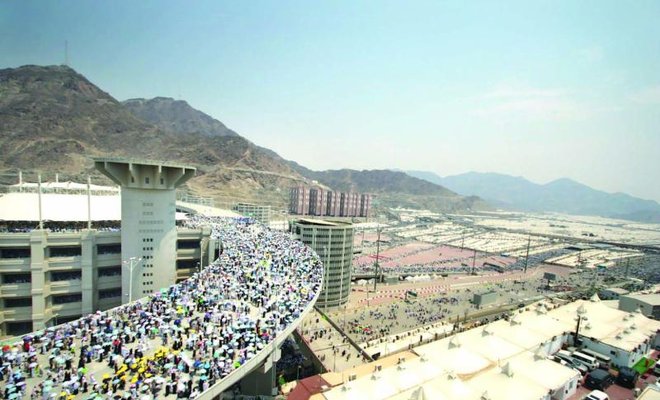
Development of Jamrat Bridge reduces hardships for pilgrims
The vastness of the Jamrat Bridge in Mina has contributed to putting an end to Jamrat incidents.
This giant structure has also contributed to easing hardship and fatigue, which badly affected pilgrims before the bridge was established in 2007.
The bridge provides eleven entrances and twelve exits in four directions, where pilgrims can gain access through six directions, including three on the south side and three on the north side.
Since it was built, the bridge has witnessed a number of developments after its widening to 40 meters, with two elevations from the eastern and western sides, and downhill next to Aqaba Jamar from the upper floor of the north and south sides for descending pilgrims.
In 1978, the bridge witnessed the addition of reinforced concrete slopes at the beginnings and ends of the bridge to the second level of the Jamaarat on both sides, against the Minor Jamari.
The bridge was enlarged in 1982 through an expansion of 20 meters’ width and 120 meters’ length from the north side to Minor Jamari.
Additionally, there was a further expansion in 1987 with an increase to 80 meters’ width and 520 meters’ length, and expansion of the elevation to 40 meters’ width and 300 meters in length.
In 1995, there was a process of adjustments at different stages that included the view of the bridge and pilgrims’ movement. It was followed by similar adjustments in 2005, that included the structure of the bridge and the adjustment of basins from ring to oval shapes.
Another project of the Jamrat Bridge included the helicopter landing pad for emergencies, in addition to a sophisticated cooling system.
of emergency.
Dr. Salim Bosta, an adviser and expert on crowd management, confirmed that organizing plans of the annual pilgrimage focused on the establishment of an infrastructure for the bridge that can be built up to around 20 floors; this is if Mina is to be used as a housing area for pilgrims during the next ten years.
He pointed out that “The overall pedestrian traffic system in the Jamrat area, its tracks and roads leading to the area, have contributed to the success of the project.”


























